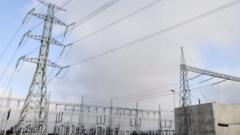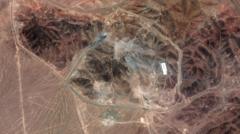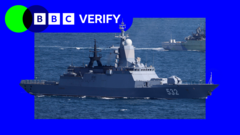Authorities in Finland are currently investigating a possible connection between a Russian ship, suspected to be part of a covert 'shadow fleet', and the damage inflicted on the Estlink 2 cable that runs between Finland and Estonia.
Investigation Launched into Russian 'Shadow Fleet' Ship Linked to Undersea Cable Damage

Investigation Launched into Russian 'Shadow Fleet' Ship Linked to Undersea Cable Damage
Finnish authorities are probing a potential link between a Russian vessel and recent damage to a crucial underwater electricity cable.
The investigation stems from an incident that occurred on Wednesday, when the Estlink 2 cable was found to be disconnected, causing significant concern over the security of the Baltic region's maritime infrastructure.
Finnish National Bureau of Investigation (NBI) Director Robin Lardot stated, "From our side, we are investigating grave sabotage.” He indicated that the anchor of the Eagle S, a tanker registered in the Cook Islands and believed to be part of a fleet transporting sanctioned Russian oil, may have been responsible for the damage.
Despite the disruption, Fingrid, the operator of the national electricity grid, assured that the cable's damage would not endanger overall operations within Finland, although repairs are projected to span several months.
Finnish President Alexander Stubb acknowledged the situation on social media, stressing the importance of mitigating risks from vessels linked with the shadow fleet.
Authorities are treating this as "aggravated criminal mischief," reflecting the increasing scrutiny on Russian maritime activities in the region. The Estlink 2 cable, an essential conduit with a capacity of 650 megawatts, measures 170 kilometers in length, primarily submerged underwater.
The necessity for greater security measures regarding undersea cables has been echoed by the European Union, with threats of additional sanctions against Russia and an emphasis on the protection of critical infrastructure.
Estonia’s Foreign Minister Margus Tsahkna highlighted that repeated incidents involving damage to key submarine infrastructure suggest a pattern that cannot be dismissed as mere accidents.
"Such systematic damage should be perceived as attacks on our vital structures," he asserted. The Eagle S has since been escorted to a port in Finland for further investigation.
This incident follows a troubling trend, including previous cases of damaged cables between Finland and Germany and between Lithuania and Sweden, as well as the unresolved investigations into the Nord Stream gas pipeline explosions in 2022.
As tensions continue to rise in the Baltic Sea, officials are steadfast in their determination to confront these security threats head-on.
Finnish National Bureau of Investigation (NBI) Director Robin Lardot stated, "From our side, we are investigating grave sabotage.” He indicated that the anchor of the Eagle S, a tanker registered in the Cook Islands and believed to be part of a fleet transporting sanctioned Russian oil, may have been responsible for the damage.
Despite the disruption, Fingrid, the operator of the national electricity grid, assured that the cable's damage would not endanger overall operations within Finland, although repairs are projected to span several months.
Finnish President Alexander Stubb acknowledged the situation on social media, stressing the importance of mitigating risks from vessels linked with the shadow fleet.
Authorities are treating this as "aggravated criminal mischief," reflecting the increasing scrutiny on Russian maritime activities in the region. The Estlink 2 cable, an essential conduit with a capacity of 650 megawatts, measures 170 kilometers in length, primarily submerged underwater.
The necessity for greater security measures regarding undersea cables has been echoed by the European Union, with threats of additional sanctions against Russia and an emphasis on the protection of critical infrastructure.
Estonia’s Foreign Minister Margus Tsahkna highlighted that repeated incidents involving damage to key submarine infrastructure suggest a pattern that cannot be dismissed as mere accidents.
"Such systematic damage should be perceived as attacks on our vital structures," he asserted. The Eagle S has since been escorted to a port in Finland for further investigation.
This incident follows a troubling trend, including previous cases of damaged cables between Finland and Germany and between Lithuania and Sweden, as well as the unresolved investigations into the Nord Stream gas pipeline explosions in 2022.
As tensions continue to rise in the Baltic Sea, officials are steadfast in their determination to confront these security threats head-on.






















